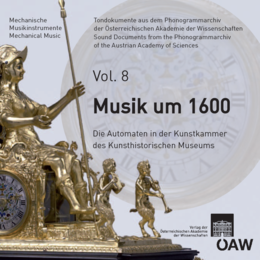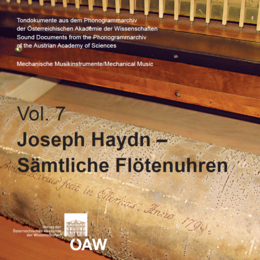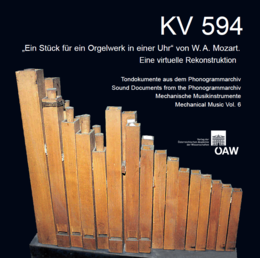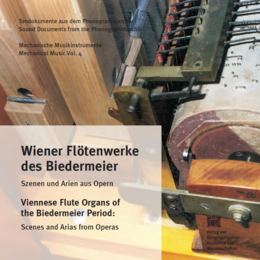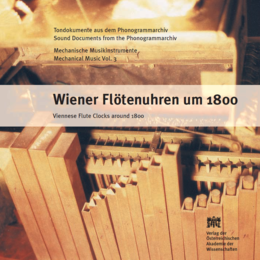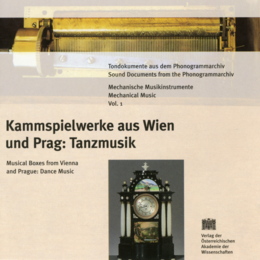Verlag der Österreichischen Akademie der Wissenschaften
Two further publications of mechanical music are found in the Verlag Cuvillier, Göttingen.
Vol. 8:
MUSIK UM 1600 – DIE AUTOMATEN IN DER KUNSTKAMMER DES KUNSTHISTORISCHEN MUSEUMS
Edited by Helmut Kowar.
OEAW PHA CD 34, 2013.
The “Kunstkammer” holds five automata (four table automata and one art cabinet) with inbuilt organ works: the Trumpeter Automaton (1582), the Imperial Ship (1585), the Bacchus Carriage (ca 1602–1606), the Walbaum Cabinet (ca 1620/25) and the Minerva Carriage (ca 1625–30). These objects rank among the earliest musical automata and acoustic sources in existence. In the course of recent restoration work it has been possible to recreate their musical output. For conservation reasons the music of the Trumpeter Automaton, the Imperial Ship and the Bacchus Carriage had to be reconstructed. The realization took advantage of partly well-preserved musical information on the automata’s program carriers (discs and wheels) and of the still functioning pipes and drums of the automata. Thus the reconstructions give the true and authentic sound of the historical performance. The status of the organ works of the Walbaum Cabinet and the Minerva Carriage allowed repair of their mechanics and playback of their music. Each automaton presents its scenery together with appropriate music. The music is surprisingly complex and displays unique examples of a performance practice showing improvised passages. The sound recordings are accompanied by transcriptions of all musical pieces.
Vol. 7:
JOSEPH HAYDN – SÄMTLICHE FLÖTENUHREN
Edited by Helmut Kowar.
OEAW PHA CD 29, 2009
Joseph Haydn composed special music for musical clocks, and he did this obviously in close cooperation with his colleague at the Esterhazy court, the court chaplain and librarian P. Primitivus Niemecz, who became especially known for his skills in building musical automata. Two flute clocks (from 1792 and 1793) are extant bearing the signature of Niemecz, two others are attributed to him. There is an additional flute clock, made by Johann Joseph Wiest, which was on exhibition until 1804 in Deym’s art gallery in Vienna, thus presenting Haydn’s music to the public – while the Niemecz clocks did not leave private rooms during Haydn’s lifetime. These five instruments have 38 musical pieces on their barrels: 18 original compositions by Haydn or arrangements he himself made of his own works, the remaining pieces probably provided by Niemecz, who was also a musician and a pupil of Haydn. Many pieces show up on two or three clocks, so that the complete edition comprises 65 titles. The five flute clocks saw a changeful history ending up in private and public ownership in Austria, Germany, Switzerland and the Netherlands. With this CD their musical repertoire is presented for the first time collectively and completely.
Vol. 6:
KV 594: "EIN STÜCK FÜR EIN ORGELWERK IN EINER UHR" VON W. A. MOZART. EINE VIRTUELLE REKONSTRUKTION
Commented by Helmut Kowar.
OEAW PHA CD 26, 2008.
Originally, Mozart’s Adagio and Allegro KV 594 was to be played on the organ automaton of an opulent diorama presented by Count Deym in Vienna in 1791, in memory of field marshal Laudon; technical problems, however, seem to have prevented this piece from ever being played. Thanks to the new CD released by the Phonogrammarchiv of the Austrian Academy of Sciences, the music of this composition is now brought to life as a virtual reconstruction. Without the expertise gained during the reconstruction of KV 608, the composition that was to follow, it would have been impossible to reconstruct the sound of Mozart’s Adagio and Allegro KV 594: practically no contemporary accounts relating to its performance practice are extant. As a result, merely four possible variants of the sound reconstruction of KV 594 are presented here; they will, however, come very close to the original intentions of both Deym and Mozart himself. What is so special about this composition is the fact that this music has presumably never experienced a historical performance; even so, its “authentic sound” – derived from appropriately selected registers of a real organ instrument – can now be listened to for the first time on this recording. It is accompanied by a detailed booklet highlighting aspects of the historical situation in 1791 and the transformation into a virtual musical reconstruction.
Vol. 5:
KV 608: MOZARTS ALLEGRO UND ANDANTE (FANTASIE IN F) FÜR EINE ORGELWALZE IM "LAUDON MAUSOLEUM". EINE VIRTUELLE REKONSTRUKTION
Commented by Helmut Kowar.
OEAW PHA CD 24, 2006.
From 1791 on Count Deym presented in his art gallery a pompous, temple-like diorama showing life-sized wax figures, the so-called “Laudon’s tomb”. The music for this picture came from a barrel organ playing Mozart’s KV 608. This musical automaton and the original cylinder with Mozart’s piece pinned on it have been lost since 1821. But it seemed possible to restore the original sound and performance, thanks to quite a number of contemporary communications and treatises, other existing historical automata and the experience gained with mechanical music of that time (cf. the Phonogrammarchiv’s research project, established in 1980). With the help of these sources an attempt was made to reconstitute the articulation and tempo of the piece, based on the music published in the new complete edition of Mozart’s works. The authentic sound was derived from a real organ by choosing adequate ranks of pipes according to the descriptions mentioned in the historical messages. The resultant sound recording, then, tries to recreate the original sound character of a small barrel organ. Since the historical sources clearly do not allow us to achieve a definite version, the CD offers five different variants, which altogether will come very close to the original features of sound and performance. An extensive text explains the background and methodological aspects of this virtual reconstruction.
Vol. 4:
WIENER FLÖTENWERKE DES BIEDERMEIER
Selected and commented by Helmut Kowar.
OEAW PHA CD 21, 2004.
While the CD published in 2002 featured the flute clock around 1800, this CD presents the larger flute works of the Biedermeier period, which are usually housed within writing secretaires. These flute works document a pronounced fondness of the public for the opera. The repertoire of the typical Viennese flute organ is dominated by Rossini in the early Biedermeier, although composers like Boieldieu were in high esteem as well. The CD also comprises works from later composers like Pacini, Bellini, Meyerbeer, Donizetti and Mercadante. There are many indications that the arrangements of the notes on the barrels are in accordance with then common performance practice. Freely treated connecting passages together with ritardandi and solo cadenzas within the arias and duets make the historical performance accessible in a way that printed sources never could.
Vol. 3:
WIENER FLÖTENUHREN UM 1800
Selected and commented by Helmut Kowar.
OEAW PHA CD 12, 2002.
In about 1790 mechanical organ works first became known in Vienna. The smaller flute clock, however, came out of fashion rather soon. Apparently, then, the smaller barrel organs which are associated with clocks belong to the early days of this type of automata. The present CD is dedicated to these instruments. In musical respects the Viennese flute clock had a marvellous start. Haydn, Mozart and Beethoven composed especially for these kind of automata. With regard to original compositions this CD incorporates all of Haydn’s pieces played by the flute clock of P. Primitivus Niemecz made in 1792. Most flute clocks did not play original compositions, but the well-known and favourite tunes of their time. Accordingly, the CD presents melodies from operas and ballets as well as some dance music.
Vol. 2:
KAMMSPIELWERKE AUS WIEN UND PRAG: OPERNMELODIEN
Selected and commented by Helmut Kowar.
OEAW PHA CD 10, 2000.
The musical boxes from Vienna and Prague represented a strong competition to the Swiss models and won prizes at national and international exhibitions from the 1830s onwards. This CD focuses on operatic melodies. The typical kind of musical arrangement of the so-called “Viennese movements” is set to achieve an easily audible melodic line and a clear accompaniment. The repertoire encompasses a variety of pieces from popular composers like Donizetti, Wagner, Bellini and Verdi, giving us an impression of the kind of music that 19th century people loved and liked to listen to in their homes.
Vol. 1:
KAMMSPIELWERKE AUS WIEN UND PRAG: TANZMUSIK
Selected and commented by Helmut Kowar.
OEAW PHA CD 6, 1999.
In the 19th century musical boxes were made in two cities of the Austrian Empire: Vienna and Prague. To this day they are appreciated for their excellent craftsmanship and outstanding quality of tone. Both the repertoire and the typical kind of musical arrangement of the instruments mirror the taste of the people buying and ordering musical automata from the 1830s onwards. The recordings on this CD preserve the favourite tunes of their time and allow an insight into contemporary performance practice.
